National Parks in Nepal
A complete guide about national parks of Nepal!
A complete guide about national parks of Nepal!
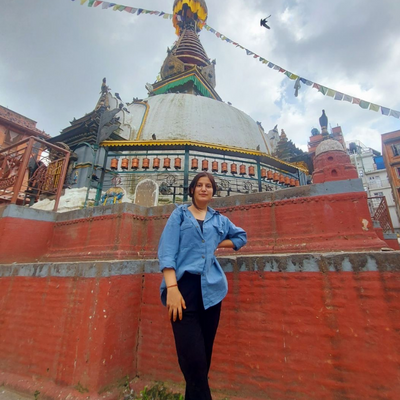
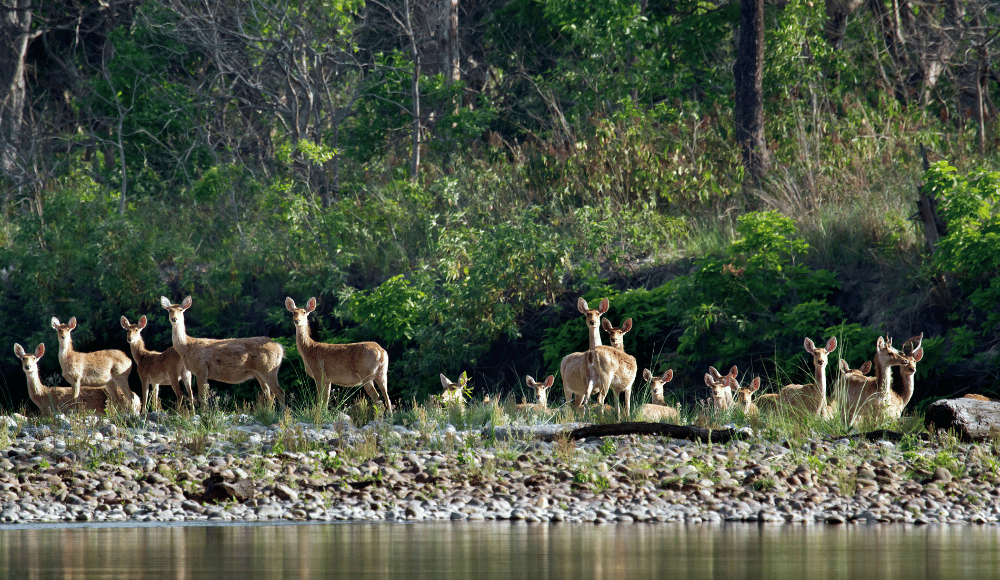
Nature, a beautiful creation of mother earth, is the home of wonder coloured by the diverse ecosystem on varied geography. The existence of this planet depends on a balanced nature with a coherent human society. And the perseverance of this ecosystem ensures the safety and security of the earth, including humans and wildlife. So, for this sole purpose, a provision is introduced focusing on maintaining and managing the natural habitat. This takes humans and their encroachment away from pristine nature, granting them a life to breathe freely, and this is what national park is all about.
A national park is a zone of nature conservation formed by the national governments. It is also a wildlife sanctuary with a hint of heritage buried underneath. So, not only will wildlife be the only concern; they are the major one, but the natural and cultural heritages are nevertheless given priority too. The main agenda of this national park is to sustain an ecosystem with well-managed resources.
Moreover, National parks are the natural habitat of distinct flora and fauna of a specific region. With the advancing world, there is a severe threat lingering above these wild ones by the newest discovery and formulations. So, for the rescue, there appears the national park, a safeguard ensuring the safety of flora and fauna of the respective region. Hence, the fundamental purpose of national parks is the protection of wildlife and their living world.
Coming to Nepal, a country rich in nature, culture, and history, would only be complete with the presence of national parks. Altogether, there are 12 national parks in Nepal, spreading from the east to the west. Shey Phoksundo national park being the largest, and the Rara being the smallest; all national parks in Nepal are highly secured and protected. Also, there are several conservation zones apart from the national parks, which focus on increasing the number of endangered species and their kinds.
If you are interested to learn what these national parks are, where they are, and how we can reach them, please go through the below-mentioned article thoroughly, it will provide you with all the essential details on the national parks of Nepal and their speciality.
|
|
|
|
|
|
|
|
|
|
|
|
Makalu Barun national park, a jewel of Eastern Nepal, was established in 1992. Its eastern part spread throughout the Sankhuwasabha district, while the western territory goes up to the district of Solukhumbu. Altogether, It covers an area of 1500 sq km, sharing a buffer zone of 830 sq km. Initially, It was the extended version of Sagarmatha national park; later, after the survey conducted by the TMI in the Babai valley, this national park got the area it boasts today.
It is preserved by the national park and wildlife conservation department; the Nepal government and the mountain institute (TMI). This national park rises from an elevation of 345 m of the Arun river to 8025m, the peak of the Makalu, making it the only national park in the world with an elevation gain of 8000m. Because of this varying altitude, the weather and climate around this region differ vastly. The lower region experiences a humid tropical climate while the upper one goes through the alpine one.
The fifth tallest peak in the world, Mount Makalu and the fourth tallest in Nepal, Mount Chamlang, reside in this national park. Apart from these two, mount Baruntse, Mera peak and many other small peaks settle in this national park, enhancing its beauty. Not only the mountains are the only glory of this national park as it is the habitat of several wild beauties. The lower region of this national park is decorated by the monsoon forests, above which lies the dense conifers, and then gradually, this treeline gets reduced and gives rise to shrubs and lichens.
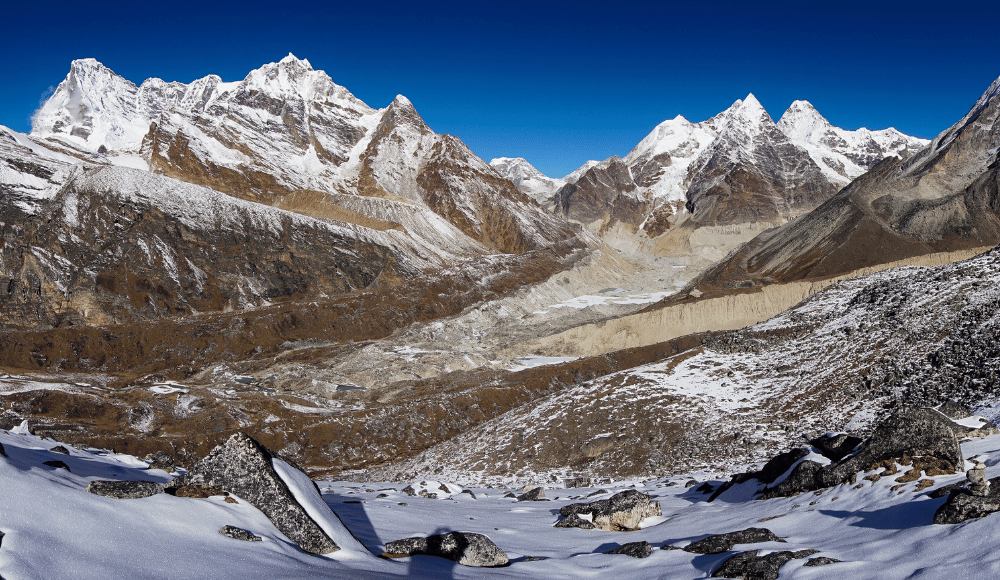
It is well known, Varying vegetation means multiple fauna adaptations. As likely, this national park is home to 440 bird species, 315 butterfly species, 43 reptile species and 78 fish species. Apart from this, it is the shelter of the elusive Snow leopard, bamboo lover, Red panda, Himalayan wildlife, Musk deer and Black boar. Because of the availability of such a vast range of nature, this national park receives hundreds of visitors yearly. Majorly trekkers hover above this region, and one common trekking point is the Makalu base camp trek.
You may already know that you can't enter the national park randomly, and need to have a permit to visit, which applies to this national park too. You need to get a Makalu Barun national park permit for this national park visit. You can get the national park permit either from the Nepal Tourism board or from the park headquarter, Seduwa. The fee structure varies by nationality as SAARC nations citizens have to pay USD 15, while for foreigners, it is USD 30. You can enjoy bird watching and Jungle safari during the national park visit. Additionally, you can join trekking, as trekking in such a rich nature feeds the most surreal experience you can ever get.
The national park suffers from the monsoon climate earlier than the other region as the precipitation starts in June and extends up to September, so definitely, it will not be the ideal time to visit. The best time for Makalu Barun national park visit is the late Autumn and early Spring. You can take a tour around this national park at this time, as it will give you a fantastic experience with the heart skipping sight of the wildlife.
Some of the major attractions of the Makalu Barun national park are listed below:
Barun river
Mt Makalu
Diverse flora and fauna
Sub alpine pastures
There are two ways to reach Makalu Barun national park, by flight and by driving. A detailed description of these two is given below:
By flight:
For the flight, you can have multiple options from Kathmandu, Biratnagar and Dharan.
From Kathmandu to Tumlingtar: You can take a direct flight to Tumlingtar from Tribhuvan international airport. It may take around 35 minutes to reach Tumlingtar from Kathmandu. From Tumlimgtar, you can take a privately reserved vehicle and drive towards Makalu Barun national park. It is the easiest way to reach Makalu Barun national park and is also widely used. Also, note that the fairs for the drive from Tumlingtar are slightly higher. Despite all this, it is preferred by many.
From Kathmandu to Lukla: The perfect adventure for adventure junkies is this, the flight to Lukla and the trek onwards. For this, you will take a flight to Lukla from Tribhuvan International Airport, which itself is an adventure. It may take around 45 minutes to reach Lukla airport from Kathmandu. After getting to Lukla, you must trek to the Makalu Barun national park. You will meet Tumlingtar, after a 12 days trek from Lukla. This can be suitable for those who want to be in the mountain ambience and love trekking as you will trek observing the Makalu and Everest throughout the trails.
From Kathmandu to Phaplu: Alternative to the Lukla flight, you can choose a flight to Phaplu from Tribhuvan International airport. It may take around 35 minutes to reach Phaplu from Kathmandu. After getting here, you can trek onward to reach Makalu Barun national park.
From Biratnagar to Tumlingtar: You can reach Makalu Barun national park from Biratnagar too. A seasonal flight to Tumlingtar departs from Biratnagar. From Tumlingtar, you can choose a public vehicle or rent a private one.
By drive:
For the drive also, you can have multiple options listed below:
From Kathmandu to Khandbari: It is commonly used and the easiest drive option to get to the Makalu Barun national park. For this, you will drive from Kathmandu to Khandbari, which may take around 10 to 12 hours. Then you can hike to get up to the Makalu Barun national park.
From Kathmandu to Lukla: It can be the best alternative for those who want to experience both the Everest and Makalu regions. First, you will drive to Lukla via Ramechhap and then trek above to reach Tumlingtar. From Tumlingtar, you can easily reach Makalu Barun national park.
|
National park |
Makalu Barun national park |
|
Park headquarters |
Murmidanda, Seduwa |
|
Location |
Sankhuwasabha, Eastern region |
|
Established date |
1992 |
|
Area covered |
1500 sq km |
|
Buffer zone |
830 sq km |
|
Peaks |
Mt. Makalu, Mt. Chamlang, Mt. Baruntse, Mera peak |
|
Preserved Flora and Fauna |
|
|
Permit fee |
|
|
Best time to visit |
|
|
Opening and closing hours |
Sunday to Saturday 12 am to 11:59 pm |
A national park dominated by the world's highest peak is the marvelous Sagarmatha national park. The name Sagarmatha means forehead of the sky, as “Sagar” means Sky, "matha” means head, and the national park is named after it. This national park is full of rugged terrains, cliffs, gorges, places of social importance, and the unique, enthralling culture in the remote mountain region. It makes this national park exceptionally beautiful, and to preserve these unique features, it was designated as a national park in 1976. Also, This is a commendable national park that can give you the ecstasy of mixed culture and nature. Noting these excellent features and their importance, UNESCO listed this national park as a world heritage site in 1979, making it the first national park of Nepal to be enlisted in the world heritage list.
Sagarmatha National Park lies in the eastern region of Nepal, province no 1, in the district of Solukhumbu, commonly known as the Khumbu region. It occupies an area of 1148 sq km with a buffer zone of 275 sq km. Makalu Barun national park is adjacent to it on the east, while the Gaurishankar conservation area follows it to the west. Likewise, in the north, it is linked with the conservation area of China, Qomolangma conservation, and to its south are the upper catchments of the Dudh Koshi river. This national park spreads from 2845m at Monjo to 8848m, the height of the gigantic Everest.
This national park is famous as a national park housing the roof of the world, but it is not the only one it poses. There are several, seven more ranging above 7000m and multiple above 5000m. Some of them are Cho Oyu, Lhotse, Thamserku, Lobuche, Amadablam, Pumori, and Nuptse. Because of the presence of many snow-capped peaks, little vegetation is observed inside the national park. This national park comprises 69% of its land above 5000m as barren terrains, 28% as grazing land, and 3% as a forested area. So, you can observe the Pine, Birch, and Juniper forests in the lower elevation.
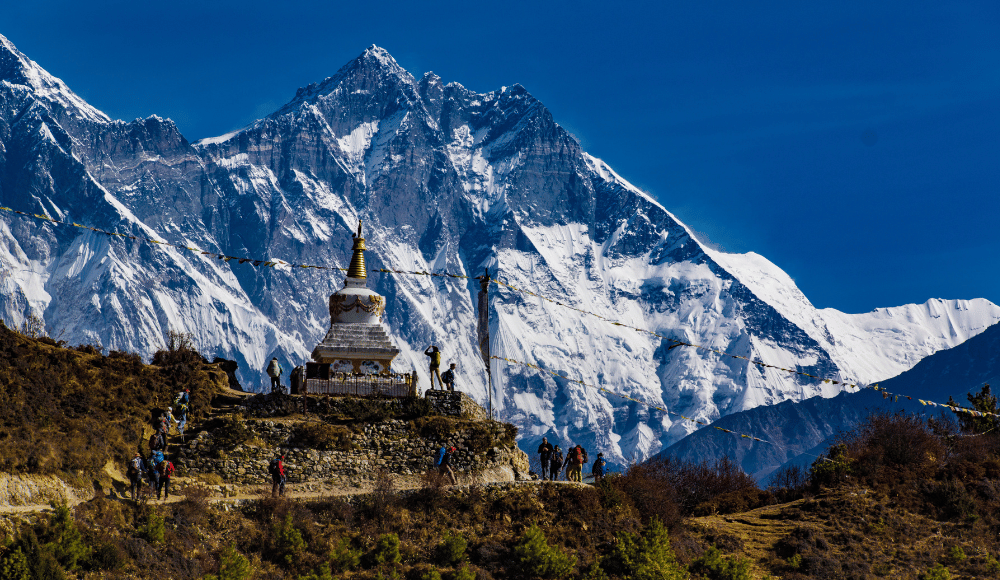
Junipers are considered sacred in this area, and the aromatic smell of these berries is found throughout the national park. Above the treeline, the national park goes through Rhododendron bushes, mosses and lichens. You can see the Himalayan Thar, and Musk deer grazing and roaming around here. Also, the Red panda is seen occasionally near the bamboo forest. Except for these, it is also the habitat of several bird species, such as the Snow cock, national bird, Danphe, Impeyan Pheasant, and many more. Reportedly it is found that this national park houses 208 species of bird and 1000 floral species.
Apart from flora and fauna, this national park is the land of the largest, longest, and most incredible glacier. Imja, Ngozumpa, and Khumbu are this national park's most prominent and glamorous glaciers. U-shaped valleys and beautiful glacial lakes are found in the upper range of this national park, shared with the seasonal sherpa settlements. Gokyo lakes and associated lakes were preserved under the Ramsar site convention in 2007. This aids the beauty of Sagarmatha national park even more.
The national park shares glimpses into the lifestyles of the Himalayan heroes, the Sherpa people. Numerous monasteries, chortens, mani stones, and mani walls can be seen scattered throughout the national park. This illustrates the religious beliefs of the locals, Buddhism, and their values and norms. One of the major and oldest is the Tengboche monastery. Different festivals are celebrated in the courtyard of this monastery. Mainly, Mani and Dumje Rudu are grandly celebrated here.
The national parks suffer from the temperate to alpine climate. The lower range may go through the temperate one, but the upper region above 5000m goes through the alpine one. So, the best time to visit Sagarmatha national park is October, November, March, April and May.
You need to have a permit for a national park visit. You need to have a Sagarmatha national park permit for this national park too. You can get this permit from the park headquarters or the Nepal tourism board, Kathmandu. The fee structure of this national park permit goes as USD 15 for SAARC nationals and USD 30 for foreign citizens. Also, as this region contains several trekking points, many trekkers march to this region. For trekking, you must also have Khumbu municipality permits. Some of the famous trekking in this region is the Everest base camp trek, Gokyo lake trek, Gokyo valley trek, and several others. The trek starts from Lukla and goes through the mountain city, Namche Bazaar.
Some of the features and attractions of Sagarmatha national park are listed below:
Namche Bazaar
Mount Everest
Monasteries, and Chortens
Khumbu and Ngozumpa glacier
Lush Rhododendron and juniper forest
Gokyo valley and lakes
Diverse Flora and fauna
Culture and tradition of Sherpa people
You can reach Sagarmatha national park in two ways, by flight or by drive. A detailed explanation is cited below:
By flight:
Flight to Lukla: To reach Sagarmatha national park, You can take a flight to Lukla airport from Tribhuvan international airport, Kathmandu. The 45 minutes scenic flight will give you the best aerial view of the Sagarmatha national park. After Lukla, You have to trek onwards for about two days to reach Sagarmatha national park. This is the effective means to reach Sagarmatha national park as it is short and feasible. Also, many visitors prefer this over others, and all the other access is the alternative.
Flight to Tumlingtar: Not only the Lukla flight is the only option to get to the Sagarmatha national park, but you can join this also. You must fly to Tumlingtar from TIA, Kathmandu and then trek onwards. This trek can usually be longer than Lukla's, usually ten days.
Flight to Phaplu: There is also a flight to Phaplu from Kathmandu; you can join that too to get to Sagarmatha national park. After you reach Phaplu, you must trek onward like the others. The only difference will be in the duration of the trek. From Phaplu, you must trek for about five days to reach Sagarmatha national park.
By drive:
Drive to Jiri: This can be the Lukla flight alternative but is the traditional one. Nowadays, only some go through this. If you choose this, You have to take a bus departing to Jiri from Kathmandu and then trek onward for about ten days to reach Sagarmatha national park. Those who love long drives can join this.
Drive to Salleri: This is commonly used nowadays. If you choose this, you don't have to trek as much as from Jiri. You just have to take a bus to Salleri, a village near Phaplu and then walk for about five days. This will take you to the magnificent Sagarmatha national park of the Khumbu region.
|
National park |
Sagarmatha national park |
|
Location |
Solukhumbu, Eastern region |
|
Park headquarters |
Namche |
|
Established date |
1976 |
|
Area covered |
1148 sq km |
|
Buffer zone |
275 sq km |
|
Enlisted in world heritage site |
In 1979 |
|
Major Peaks |
Mt. Everest, Lhotse, Cho Oyu, Thamserku, Nuptse, Amadablam, Pumori |
|
Major Glaciers |
Ngozumpa Glacier, Khumbu glacier, Imja and Nangpa glacier |
|
Preserved Flora and Fauna |
|
|
Permit fee |
|
|
Best time to visit |
|
Langtang national park is the nearest national park to the capital Kathmandu. It is also the country's first Himalayan national park, designated in 1976. Lying only 32 km north of the capital Kathmandu, this national park is a hooking point of the indo- Malayan and Palearctic realms. This grants this national park a uniqueness with its enriched biodiversity. The preservation of this national park is assigned to DNPWC, which is responsible for maintaining the resources of the park.
Langtang national park occupies an area of 1710 sq km with a buffer zone of 420 sq km. Its region is scattered through the districts of Sindhupalchowk, Nuwakot and Rasuwa, the central Himalayas region of Nepal. This national park connects with the Qomolangma conservation zone of China in its north, guarding its east and west territories are the Bhote Koshi and Trishuli rivers.
Langtang national park boasts large floral species by the influence of the two most significant geographical realms. The national park spreads from 1000m to 7245m, with various vegetation. The dense monsoon forest with plenty of lush old growth wildly covers the lower region. The thick treeline is usually found near the river bank and the valleys. Above the treeline lies the colorful rhododendron forests, as this national park is known for several rhododendron species. In the spring month, the whole valley is lit by these multicolored rhododendrons.
Conifers are found at an elevation of around 5000m; mainly, the Oaks and Pines dominate the area. Typical Nepali firewood Saal, Chilaune, and Chirpine are prominent in this region. Coming to the higher one, barely a few are found because of the temperature. This diverse range of vegetation in this region makes this national park a perfect hide for wild beasts such as Snow leopards, Ghoral, Serow, Musk deer, Red pandas, black bears and many more. Also, this national park is well known for 250 species of birds, and one can enjoy bird watching here, especially in the winter, as the migratory birds roam here around this time of the year.
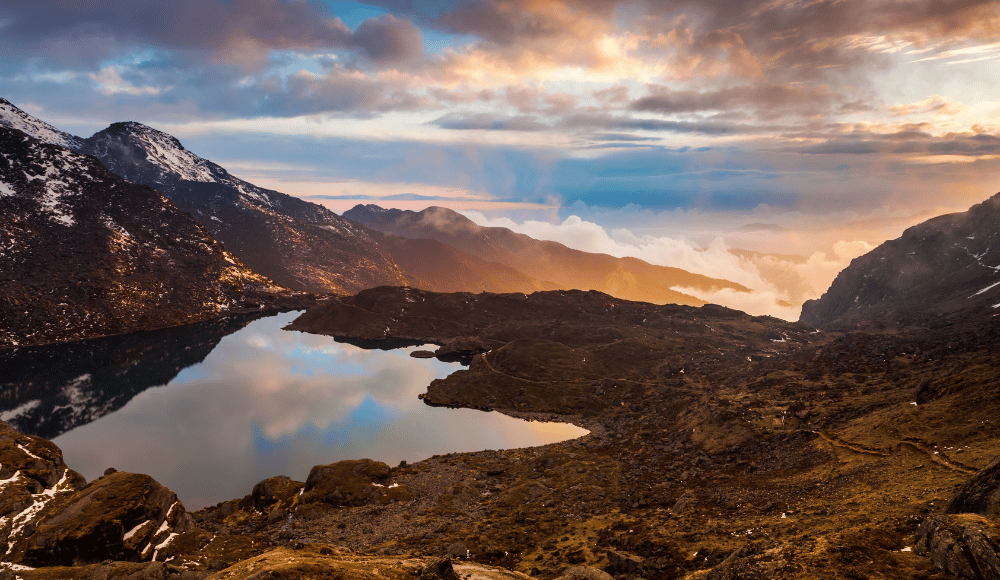
The highest point of this national park is Langtang lirung which is appreciated for its glamorous look. Accompanying this are several other snowy peaks. Also, there are many waterfalls, lakes and rivers in this national park. So, this national park is best suitable for trekking around with friends. Some of them are Langtang valley trekking and Helambu trekking. This is the geographical beauty of this national park, but surprisingly this national park is also home to several religious beliefs and significance. One of the major sites is the Gosaikunda lake. Every year in August, hundreds of visitors trek to this region to take a holy bath on Janai Purnima. Also, Tamang being the primary northern resident, this national park is coloured with their unique customs and practices.
This national park experiences four seasons within the year, Autumn, Spring, Winter, and Summer. The lower elevation follows the temperate climate while the upper zone goes through the alpine one. It receives maximum precipitation in the monsoon period, making it quite unfavorable. So, the best time to visit this national park, except for the monsoon period, can be year-round.
You need to have a national park permit to enter this national park, which is the Langtang national park permit. You can get the national park permit from the Nepal tourism board or the park's headquarters. The permit cost is USD 15 for SAARC nationals and USD 30 for foreign citizens. Also, Children below 10 yrs can skip paying for the national park permit.
Some of the features and attractions of Langtang national park are listed below:
Langtang valley
Gosaikunda lake
Helambu
Langtang lirung mountain and glacier
Waterfalls
Tamang culture and tradition
Though multiple options exist to reach Langtang national park, these two are the shortest and easiest via Syabrubesi and Melamchi.
Via Syabrubesi:
This is the often-used trail to reach Langtang national park, which will take you through the gateway of the national park, Syabrubesi. If you plan to visit on a public basis, you can get a bus from Machhapokhari that departs early in the morning from 6 to 9 am to Syabrubesi. Apart from this, you can reserve some private vehicles that will take you to Syabrubesi. The public mode may take 7 to 8 hours to reach Syabrubesi, while the private means can be faster though it is costlier.
Via Sundarijal:
This is also the better alternative for the Syabrubesi trail. For this, you have to take a daily bus departing to Sundarijal. You can choose the public one or the rented vehicle as per your choice. You can get the public vehicles departing early, from 7 to 8 am, to Sundarijal from the Old bus park. It may take 4 to 5 hours to reach Sundarijal from Old bus park, Kathmandu. Going for the private one will be much faster as you will go directly to the Sundari Jal without stopping at any stop. Also, It has become the recent favorite trail to reach the Langtang national park from Kathmandu, which is short and easy.
Langtang National Park Facts
|
National park |
Langtang national park |
|
Location |
Rasuwa, Nuwakot and Sindhupalchowk district |
|
Established date |
1976 |
|
Area covered |
1710 sq km |
|
Buffer zone |
420 sq km |
|
Major attractions |
|
|
Preserved Flora and Fauna |
|
|
Permit fee |
|
|
Best time to visit |
|
Shivapuri Nagarjuna national park is the pride of the capital, Kathmandu, settling in the northern fringe of the valley. Initially, it was the water catchment area supplying water for the entire Kathmandu valley. So, given a title of a protected watershed area. The name Shivapuri is given after the peak Shivapuri of 2732 m, making it the nation's ninth national park in 2002.
Later it was merged with the Nagarjuna forest reserve, naming it Shivapuri Nagarjun national park with a large area of 159 sq km. With its diverse flora and fauna, this national park receives significant visitors because of the nearest accessibility, only 12 km from the capital Kathmandu.
The pious Bagdwar and Bishnudwar are the resources of the river Bagmati and Bishnumati, hence holding strong religious beliefs. These are the hiking spots in this national park which get large crowds every Autumn and Spring. Also, this national park lies within the Langtang trekking trail, which means you can also find trekkers through this region.
This national park is scattered through the transition zone of temperate and subtropical climates. Hence dense Rhododendrons, Pines and Oaks are observed in this national park. The majority of the national park's area is covered by these species making it a habitat for several wild species, such as the Himalayan black bear, Leopard, Rhesus monkey, Jungle cat, and several species of birds. Reportedly this national park lists 117 species of birds and 102 species of butterflies.

This national park can be visited year around. Each season offers the best it has got, but still, it is less visited during summer seasons. The winter here is chilly and vivid; spring, the positive environment and the autumn perfect clear sky. So, this national park bestows something new and exquisite in every season.
Glamorous Himalayan vistas are observed from the northern fringe of this national park, while from the southern one, you can get a view of the beautifully settled Kathmandu valley. To get this, hikers hike up to the viewpoint. Also, only one permit is required for this national park visit, which is the Shivapurin Nagarjuna national park permit. You can get the permit from NTB, or the park sectors, which costs USD 10 for foreign citizens while USD 6 for SAARC nationals.
Some of the features and attractions of Shivapuri Nagarjun national park are listed below:
Diverse flora and fauna species
Shivapuri peak
Bagdwar and Bishnudwar
Trekking trails to Sundarijal, Langtang, Nagarkot and many more
The easiest way to reach Shivapuri national park is to take a bus to the Budhanilkantha bus park. You can get the bus from Ratnapark or Narayanthan chowk. After that, you have to hike for about 10 to 15 minutes to reach the entrance point of the national park in the Budhanilkantha sector. There are four sectors of the Shivapuri national park, including the Pani muhan sector, the Dhakalchour sector, the Sundarijal sector, and the Nagarjuna sector; you can pay a visit to any of these national park sectors.
|
National park |
Shivapuri Nagarjun national park |
|
Location |
North side of Kathmandu valley |
|
Established date |
2002 |
|
Area covered |
159 sq km |
|
Buffer zone |
118.61 sq km |
|
Preserved Flora and Fauna |
|
|
Activity to do |
|
|
Permit fee |
|
|
Best time to visit |
Year around |
Parsa national park lies in the lowland of Terai, in the south-central region of Nepal, over the districts of Parsa, Bara, and Makwanpur. This protected area used to be the hunting ground of the Rana dynasty rulers during their vacation period back in ancient times. After the end of the Monarchy, this area was protected as a wildlife reserve in 1984. Not only is wildlife their only concern, but also the pristine habitat as well is another region behind the conservation. The historic char koshe jhadi of Terai is preserved under this.
Later in 2015, an area of 128. 39 km sq of the Bara district was merged into this wildlife reserve, making it a national park in 2017. Altogether it comprises an area of 627.39 sq km with a buffer zone of 285.30 sq km. This national park is preserving the Asian wild elephants and their pristine habitat. This national park meets the Chitwan national park in its west and is adjoined to the Valmiki tiger conservation of India. The great Rapti river and the majestic Siwalik hills border the northern territory of this national park.
This national park goes through tropical and subtropical climates, so the national park is covered by the broad leaves of floral species. 90% of this national park is occupied by the deciduous Saal forests, followed by the Khair and Silk cotton tree on the river banks. These dense woodlands make the ideal shelter for wild beasts such as the Royal Bengal tiger, Asian wild elephant, One-horned Rhino, hog deer, Palm Civet, Chital, Sloth bear and many more. Hundreds of crowds flock to this national park to gaze at these wild beauties.
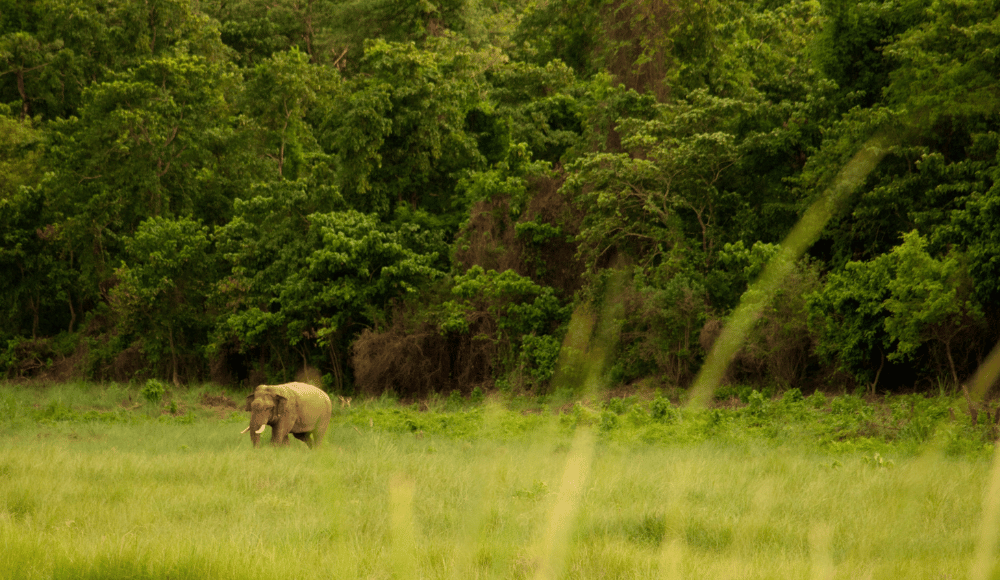
Parsa national park is also home to 500 species of birds. In the autumn months of September, and November, and the winter months of January and February, this national park receives migratory birds from the northern hemisphere, giving the perfect opportunity for bird watching. For wildlife viewing, this national park has constructed multiple view towers from where you can gaze at them. In Addition to the flora, fauna, and birds, this national park also houses several reptile species, such as Common Krait, Banded Krait, Python, Common Cobra, and King Cobra.
You can visit this national park in September, November, February, and March to get the best of what this national park offers. Except this, it is also visitable in all other seasons except the monsoon season. In monsoon time, it receives heavy precipitation, and as the soil here is pretty susceptible to erosion, multiple floods and landslides may occur. Apart from this, you can tour this national park at any other time.
Parsa national park along with the Bardia national park are conserving the endangered Royal bengal Tiger. Sometimes the dense grassy field hides this predator and its preying species while sometimes flashes them involved in some activity. During this national park visit, you can enjoy a Jungle safari from various spots, which may grant you a perfect chance to encounter such beauty.
In the winter, the buffer zone villagers are allowed to cut the thatch grass of the national park, Sabai grass. This allows the visitors to peek at the wild ones, which are pretty visible because of the sparse bushes. Coming to the permits, you need to have a national park permit to enter this national park. You can get the permit from the park's headquarter or Nepal Tourism Board. It charges NRS 750 for SAARC nationals and NRS 1500 for foreigners. You can enter the national park through this permit, but you have to pay extra to conduct activities such as Jungle safari and elephant rides.
Some of the features and attractions of Parsa national park are listed below:
Royal Bengal tiger
One-horned Rhino
Asian wild elephant
Sloth bear
Siwalik hills
Rapti river
500 Bird species
Halkhoria lake
It is easy to reach Parsa national park from Kathmandu. Since the Kathmandu- Hetauda- Birgunj highway passes through the park entrance gate, you can simply take a bus from Sorakhutte, Kathmandu. It may take around 6 to 7 hours to reach the park entrance gate this way. Alternatively, you can take a flight to Simara airport, Bara, from TIA Kathmandu and then take a public or private vehicle to get to the park's entrance gate. These are the easiest way to reach Parsa national park. You can have multiple options, though.
Parsa National Park Facts
|
National park |
Parsa national park |
|
Location |
South central lowland of Terai in the district of Parsa, Bara, and Makwanpur |
|
Established date |
1984 |
|
Area covered |
627.39 sq km |
|
Buffer zone |
285.30 sq km |
|
Major Flora and Fauna |
|
|
Activities to do |
|
|
Permit fees |
|
|
Best time to visit |
|
The first national park of Nepal is the royal Chitwan national park which lies in the inner lowlands of Terai in south-central Nepal. It is scattered over four Terai districts, Chitwan, Nawalparasi, Parsa, and Makwanpur. This national park meets the Parsa national park in its east, while in the west and north, it is guarded by the Rapti - Narayani river system. At the same time, in the south, it joins with the Valmiki tiger conservation of India.
The churia hills, alluvial flood plains, and the thatch grassland inside the national park make the national park a suitable habitat for several endangered species and distinct flora. This national park is enriched in vivid ecosystems, but in the old time, it was not what it is today. In the initial days, this national park used to be the hunting ground of the ruling class as it offered several varieties of wild species.
In 1959, the late King Mahendra designated an area of 185 sq km from the Tikauli forest on the Rapti river shore to the foothills of the Mahabharata as Mahendra Mriga Kunja. It unknowingly became the first step for this national park's foundation. Later in 1963, the southern area of the Rapti river was restricted as a rhinoceros sanctuary which laid the root of this national park formation. Finally, after ten years, in 1973, valuing the diverse ecosystem here, this region was given the title of a national park, making it the first-ever national park of Nepal.
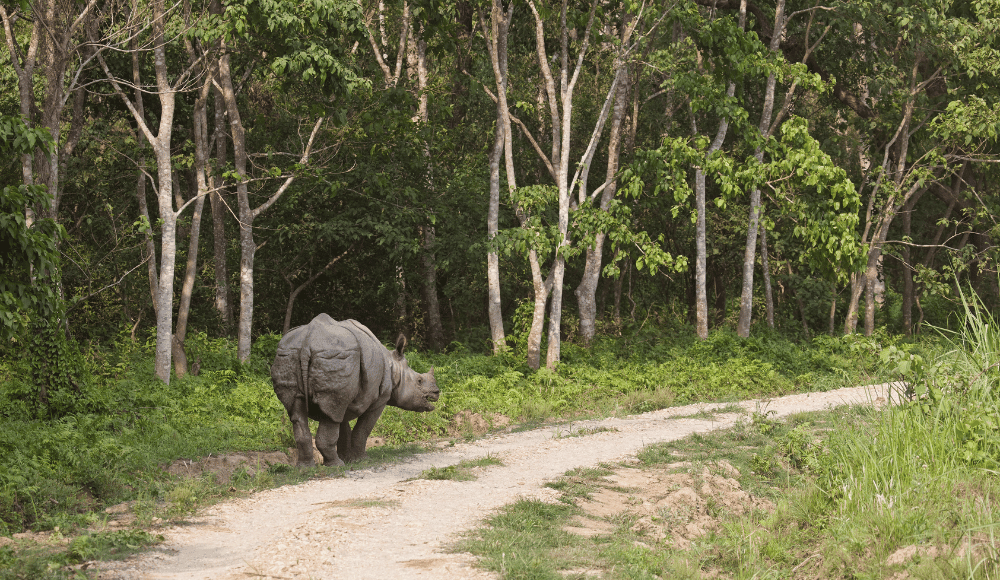
Discovering the richness in every aspect of culture, heritage and nature, UNESCO listed this national park as a world heritage site in 1984. This national park covers a total area of 952. 63 sq km, along with a buffer zone area of 729.37sq km. This national park is the best example of a community-government-based protected area. The buffer zone committee also looks after the protection and preservation of the national park, not only the armed forces from the Nepal government. The unspoilt original Tharu culture is observed inside the national park, allowing you to taste the culture, not only the wildlife views, unlike other national parks.
This national park is covered by the sal forest for the most part, while the floras of the Siwalik hills color the remaining part of the national park. This national park is also called the forest's heart because of its diverse flora and fauna. The deciduous woodlands, numerous shrubs, thick bushes, and religious sites make this national park rich in biodiversity and culture. Aiding more to it, this national park has a Ramsar site, Beeshazari Taal, in its buffer zone, making it more prominent, unique and diverse than others.
This national park conserves the endangered one-horned Asian rhino, Asian wild elephant, Royal Bengal tiger and Gharial crocodiles. This national park has significantly shown the growth of this extinction brink species, as their numbers are rising gradually then the late 90s. Annually the one-horned rhinos are translocated to Bardiaya and Shuklaphanta national park for prevention in case of any epidemics. These types of highly sustainable majors have been taken for wildlife conservation by this national park and the concerned authority, which falls under the national park and wildlife conservation department.
This national park is the home of 68 mammal species, 56 species of Herpetofauna, 544 bird species, various numbers of Four-horned antelope, Golden monitor lizard, Striped Hyena, Gaurs, leopards, different cat species, wild dogs, sloth bears, foxes, palm civets, marsh muggers, Python and many more.Chitwan Jungle safari allows you to catch the glimpse of these fantastic beasts, though multiple appearances of several kinds during your time of visit rely on your own personal luck. The chance of spotting the royal Bengal tiger during your Chitwan wildlife safari is pretty slim, as they roam in the inner dense forest most of the time. Except for this, you can catch numerous sights of other wild species during your visit, including rhinos, elephants, deer, jackals, marsh muggers, and crocodiles.

During the winter, the migratory boards are seen hovering over this national park and the Ramsar site, allowing the perfect bird-watching opportunity. Also, inside the national park, 6 to 7 lodges are in operation by the national park officials or their relationship, which allows you to look into the wildlife of this national park. Inside the national park, here flows the Rapti river, where you can go boating in a handmade boat. This allows you to have a moment to cherish the naturally blessed Chitwan national park while rising in the astonishing Himalayan water of the Rapti river. This also grants an opportunity to gaze at the crocodiles nearer and closer.
Inside this national park, there is also a breeding center, elephant and crocodile breeding center. Here you can watch the different life cycles of this fascinating kind. Not only this, but this national park also has a Tharu museum where you can have a peek into the Tharu lifestyles, their originality, culture, customs, ornaments and attire and antics. Also, the religious Bikram baba temple and Balmiki ashram lie inside the national park, and visitors with religious beliefs visit here. This concludes that Chitwan national park is rich in every aspect, whether it be nature, history, culture, or traditions.
Chitwan national park experiences a sub-tropical monsoon climate. Hence the air around here is much more humid most of the time with the heavy precipitation in the monsoon period. Though the alluvial flood plain acts as the habitat for the wild ones, this also becomes a threat in the monsoon time, as there is a massive risk of flood here. So, the best time to visit Chitwan national park is late September to Early December, and March to April. You can get the best of this national park during this time, though you can also pay a visit at other times.
There are nine entrance regions to enter Chitwan National park. You can enter this national park with a national park permit from any of the regions, but the most visited entrance region for this national park is from the east and the west, which are the Sauraha and the Meghauli, respectively.
Some of the features and attractions of Chitwan national park are listed below:
One-horned Rhino
Royal Bengal tiger
Gharials crocodiles, and Marsh muggers
Bird species
Beeshazari taal
Dense lush grass field
Alluvial flood plains
Elephants
Tharu Museum
Bikram baba temple and Valmiki ashram
It is effortless to reach Chitwan national park, you can either take a public vehicle or the private one from the capital Kathmandu. In this case, it is advisable to take a private vehicle, as traveling in a public vehicle may be a little uncomfortable because of the crowd. So, a private vehicle is the better option. It may only take about 4 to 5 hours to reach the national park on a private basis from Kathmandu.
Also, you could choose an air option to get to the national park. You can take a flight to Bharatpur, Chitwan from TIA Kathmandu and then take a taxi or some private vehicles up to the park gate. The flight duration is only 15 minutes, and then you can enter the national park from any of the regions, Sauraha or Meghauli. Sauraha is only 17 km from the airport, and Meghauli is 27 km.
|
National park |
Chitwan national park |
|
Location |
South central Nepal, lowlands of Terai |
|
Park headquarter |
Kasara, Chitwan |
|
Established date |
1973 |
|
Area covered |
952.63 sq km |
|
Buffer zone |
729.37 sq km |
|
Declared as world heritage site |
In 1984 |
|
Preserved Flora and Fauna |
|
|
Activities to do |
|
|
Permit fees |
|
|
Best time to visit |
|
Banke national park is the nation’s tenth national park known as the gift to the earth. It is the national park preserving the fantastic landscapes and the confounded ecosystem. This national park was established in 2010, covering an area of 550 sq km in the Banke district. Though the entire national park area lies within the Banke district, this national park's buffer zone covers an area of 343 sq km and spreads in the mid-development region districts Dang, Salyan, Bardia and Banke.
Banke national park meets the Bardia national park in its west, while the Suhelya wildlife sanctuary joins this national park in the south through the community and national forest zone. The Rapti rivers and the Babai rivers create a linear boundary between human lives and encroach on the south and north of the national park, respectively. Similarly, The buffer zone of the national park houses several ethnic groups, which include indigenous Tharu, Brahmin, Chettri, Magar, Majhi, Tamang and many more. These buffer zone communities look after the national park and its preserving species in coordination with the Nepal government.
This national park is reported to have eight ecosystems: the saal forest, riverine forests, savannah, grassland, foothills of the Churia range, flood plain and likewise. This national park looks after the flora varieties more than the fauna. Though the Saal forest covers ninety percent of the national park area, the remaining region is surrounded by the Churia hills vegetational species. This national park reportedly has 124 plant species and 85 shrubs and climber species. The alluvial flood plains and the vegetation of the churia hills provide the best habitat for endangered species such as Tigers, Four-horned antelope, striped hyenas, Gharials, Pythons and likewise.
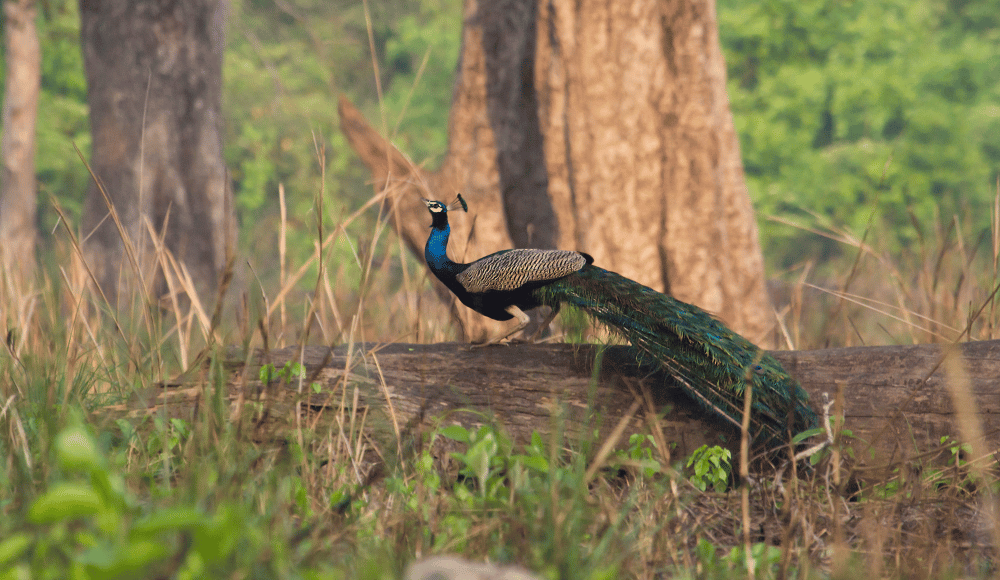
The corresponding linking of this national park with the other national park makes it more unique as it contrasts with the diversity. Because of the dense forest and vegetation, this national park likely receives more precipitation year-round than other national parks. This national park suffers three climates within the year, winter, summer and monsoon. Winter gets pretty cold here with the thick fog till the afternoon; the nights are severely cold, while the monsoon starts after July and runs till September. The summer results in the drought with the scorching sun and temperatures ranging over 45 deg Celsius. So, the best time to visit this national park is from October to April. You can get the best of this national park with all its charisma during this time.
Just like the other protected area requires a special permit to enter the zone, this national park also needs a permit to enter, which is the Banke national park permit. You can get this permit from Nepal Tourism Board, the park headquarters, or the park sector. Getting this permit is not that hazardous, and you can quickly get it. The permit costs NRS 750 for SAARC nationals and NRS 1500 for foreign citizens. Through this, you can make an entry to the national park and explore it.
Some of the features and attractions of Banke national park are listed below:
Array of eight ecosystems
Royal Bengal Tiger
Four-horned Antelope
Bengal Florican, Lesser Florican
Striped Hyena
Gharials and Pythons
There can be multiple ways to reach Banke national park but two specific ones are the easiest way to reach Banke national park. You can take a flight to Nepalgunj from Tribhuvan international airport, Kathmandu and then take a private vehicle to the park's headquarters. It may take an hour to reach the park's office from Nepalgunj. Alternatively, on the flight to Nepalgunj, you can choose a drive while the other remains the same. Additionally, you can access this national park through Mahendranagr, and Dhangadhi, too, as it takes a drive of 8 hours and 7 hours to reach the Parks head office, respectively.
|
National park |
Banke national park |
|
Location |
Banke district, mid-western region |
|
Established date |
2010 |
|
Area covered |
550 sq km |
|
Buffer zone |
343 sq km |
|
Preserved Flora and Fauna |
|
|
Activities to do |
|
|
Permit fees |
|
|
Best time to visit |
|
A national park in the lowland of Terai with diverse nature and rare environs is the Bardia national park. This Bardia national park lies in the Lumbini province, in the district of Bardia, occupying an area of 968 sq km. It is also the largest national park in the lowland of Terai, with a buffer zone of 327 sq km. This national park shares a coherent area of 1347 sq km with Banke national park as the Tiger conservation zone, which makes this national park a preliminary habitat of the Royal Bengal Tiger.
The western part of this national park is bordered by the Karnali river, the northern territory is bounded by the crest of Siwalik hills and the Nepalgunj- Surkhet Highway forms the southern border for this national park while the Babai river bisects the national park. Bardia national park used to be the hunting ground of the royal bloodline in ancient times. In 1969 an area of 368 sq km of this national park was given the title of Royal hunting Reserve.
Later in 1976, considering the exotic species of this national park and the resident ones, a small area was gazetted as the Royal Karnali wildlife reserve. After six years, in 1982, this region was named Bardia wildlife reserve but has not included the Babai valley, a roaming zone and the habitat of the flagship species. So, in 1988 including the Babai valley with a total area of the current size, the protected area was given the title of the national park, hence the name Bardia national park.
Bardia national park is the habitat of the flagship Rhino, Royal Bengal Tiger, 61 mammal species, 513 bird species, 42 herpetofauna and 120 fishes. Babai valley is the center of this national park where these wild beasts are seen roaming around. Rhinos are seen grazing here, while the giant Asian elephants are seen trampling, and the Tigers lurk behind the bushes targeting their prey.
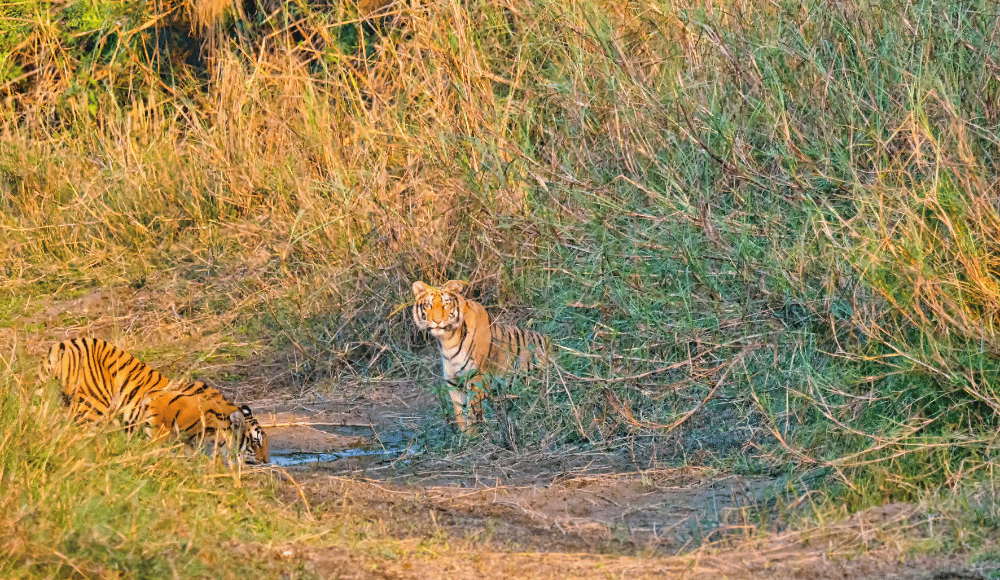
You may get a chance to spot this during the Bardia wildlife safari. Also, tiger tracking can be done in this national park based on the scats, pugmarks, and scratches on the trails and the tree branches. This activity is unique as no other national park offers this adventure. Not only this, the Karnali river, which flows on the west of this national park, gets the dolphins occasionally, Especially in the monsoon times, this freshwater giant is seen swimming in this national park.
Most of the national park's area is covered by the Saal and Savanna forests, and the remaining is occupied by the riverine and the thatchy buses. The alluvial floodplain makes the ideal shelter for the endangered Rhino. In the winter and autumn, migratory birds from Earth’s northern hemisphere are seen flying in this national park on the river banks, which offers the best birdwatching opportunities.
Bardia national park goes through three climate changes, Monsoon, Summer and Winter. Winter here starts after late December and lasts till February, while the summer hits early April and gives rise to the monsoon rain. The days are humid except for the winter months. The temperature rises fiercely in the summer, making it unbearably hot on the days. So, the best time to visit Bardia national park is Late September to November, and late February to early June. You can visit this national park at this time to get the best out of what this national park offers.
To visit Bardia national park, you need to have a national park permit, which is the Bardia national park permit. You can get this permit from the Nepal Tourism Board or the park’s headquarter. The cost for the permits varies by the nationals as SAARC national citizens have to pay NRS 750, and the foreign ones have to pay NRS 1500 to enter the national park. The activity you perform inside the national park comes with extra charges.
Some of the features and attractions of Bardia national park are listed below:
Babai valley
Tharu culture
Karnali river
Faunas in the wilderness
Though there can be multiple ways to reach Bardia national park, the easiest is the flight to Nepalgunj from Kathmandu, which takes about 50 minutes. Then you can take a privately rented vehicle to the park headquarters in Thakurdwara. This is the easiest and quick way to reach Bardia national park. Except for this, if you wish, you can choose the drive option and join that too, but it will be long, and you may have to rest for a night.
|
National park |
Bardia national park |
|
Location |
Bardiya district, the lowland of Western Terai |
|
Established date |
1976 |
|
Area covered |
968 sq km |
|
Buffer zone |
327 sq km |
|
Preserved Flora and Fauna |
|
|
Activities to do |
|
|
Permit fees |
|
|
Best time to visit |
|
Shey Phoksundo national park is the largest national park in the trans-Himalayan region of Nepal. Occupying an area of 3555 sq km, this national park spreads through the district of Mugu and Dolpo, though a large portion of the national park lies in Dolpo. It covers an area of 1349 sq km as a buffer zone area. Hence the buffer zone committee and the DNPWC are responsible for the park's management and protection. This trans-Himalayan park was named a national park in 1984.
Shey Phoksundo National park biodiversity enriches national parks with varying landscapes. The southern part of this national park boasts a treeline with the riverine forests. At the same time, the northern part flashes the barren hills. The landscape, flora, and fauna change with the elevation, making it a magnificent trans-Himalayan national park.
The prime attraction of this national park is the lake, Shey Phoksundo. This turquoise blue lake is the deepest and second largest lake in Nepal. This lake occupies an area of 494 ha and settles in the beautiful Sulighada valley. The Sulighad valley is another wonder of this generous Phoksundo national park. The name of this national park, Phoksundo, is given after this lake, as it is well known as the national park of lake Phoksundo. This national park extends from 2130 m to 6883m, the peak of Kanjirowa providing it with a variety of biodiversity.
This national park lies behind the great Dhaulagiri and Kanjirowa massif, hence experiencing the arid climate in the northern region. Surprisingly the southern slope of this national park receives a little rain during the monsoon, making it appropriate to live for the buffer zone residents and proper for the little vegetation. Above 2500m, the dry air means the alpine climate passes by. So, divergent flora and fauna are observed in this national park.
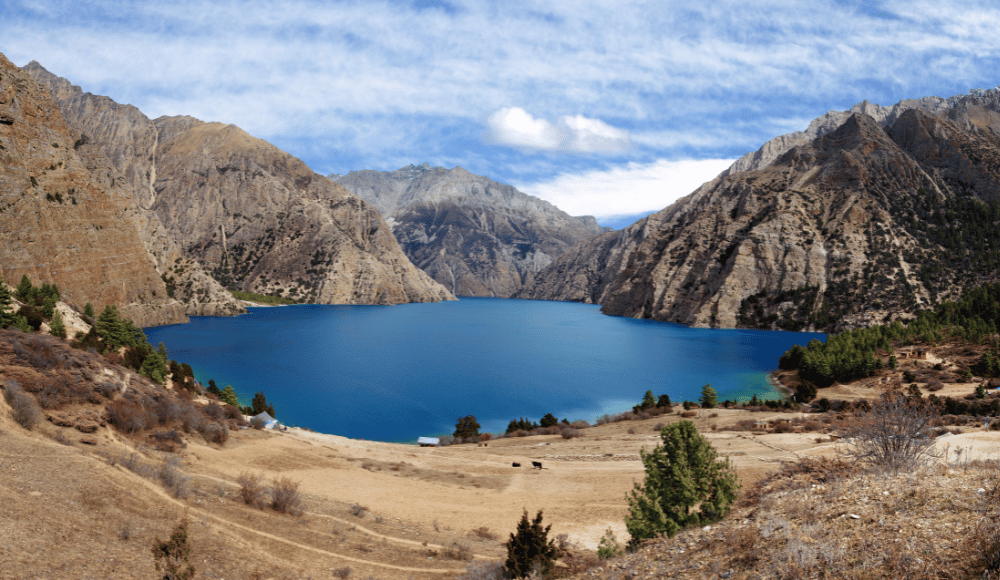
The Sulighad valley has a dense riverine forest surrounding the magnificent Phoksundo lake, which is best for trekking. It is the only dense vegetation in this national park, with Rhododendrons, Junipers, Himalayan birch, Caragana shrubs, Salix, and Himalayan fir. Above this, the vegetation decreases as if treelines are eliminated and replaced by shrubs and bushes. Also, this national park is famous for its ethnobotanical importance, as reportedly 286 herbs of such matter are found here. One of the majors is Yarsagumba. In early June, the villagers are allowed to collect Yarshagumba, so you may find a company during this time if you trek to this national park.
Coming to the fauna, this national park is the habitat of the elusive Snow leopard, Indian leopard, Grey Wolf, Golden Jackal, Musk deer, Blue Sheep, Himalayan Black Bear, and many more. Also, Six reptile species, 200 bird species and 29 butterfly species are observed in this national park. The highest-flying butterfly in the world, Pyrgus, is seen in this national park making it more unique and vivid.
Not only flora and fauna, but this national park is also renowned as the national park preserving ancient culture and tradition. The ancient BonPo religion is found in this national park near lake Shore. BonPo religion is based on the root of Buddhism but slightly differs from it. This reflects the Tibetan influence on the local residents and their unique lifestyles.
This national park is coloured by the multiple chortens, gompas, and old architecture monasteries. The Shey Gompa, built in the 11th century, resides in this national park bearing huge religious beliefs and significance. In the yard of this gompa, a huge fair is organized on the occasion of the Shey festival, which is celebrated every 12 years. Similarly, other Gompas and monasteries dated over the centuries have become the center for luring visitors to this national park with its history and folklore. Likewise, the villages and the hidden valleys with the high passes are another lime stealer of this national park. Dho village and Ringmo village are two particular villages where you can find the unspoilt Tibetan culture and practices. So, this national park offers all the culture, ecosystem, tradition, and monuments, making it exceptional.
Since this national park suffers from two climates, monsoon and arid, the time of visit for this national park also varies. The best time to visit this national park can be March to May and September to October though you can pay a visit during all months except the severe winter months as the cold becomes extreme here. Also, you can’t randomly visit this national park just with a national park permit. Some of the territories of this national park are on the restricted list of Nepal. Hence you need to have a restricted area permit before entering this national park, though a visit to Ringmo village and lake Phoksundo does not require the restricted permit.
Some of the features and attractions of Shey phoksundo national park are listed below:
Shey Phoksundo lake
Kanjirowa peak
Dho, Ringmo village and hidden valleys
High passes
The quickest way to reach Shey Phoksundo national park is by flying to Nepalgunj. You can take a flight to Nepalgunj from Tribhuvan International airport, Kathmandu, which may take an hour. After arriving at Nepalgunj, you must take a flight to Juphal, which marks your arrival at the Shey Phoksundo national park. From Juphal, you must trek to the park headquarters, Sulighad. This is the most accessible access to the Shey Phoksundo national park. Alternatively, you can choose multiple trekking trails to reach this national park.
|
National park |
Shey Phoksundo national park |
|
Location |
Dolpo, mid-western Nepal |
|
Established date |
1984 |
|
Area covered |
3555 sq km |
|
Buffer zone |
1349 sq km |
|
Activities to do |
|
|
Preserved Flora and Fauna |
|
|
Activity to do |
Trekking |
|
Permit fees |
|
|
Best time to visit |
|
Rara national park is the smallest national park of Nepal, distributed over the district of Mugu and Jumla in the far northwestern region of Nepal, occupying an area of 106 sq km. This national park is one of the most remote national parks without direct access, though rich in natural prospects. This protected area was named a national park in 1976 after lake Rara, which is also the prime feature of this national park.
Rara national park, as the name suggests, is the national park of lake Rara. Rara is the largest lake in Nepal, covering a land area of 1583 ha. It is an oligotrophic freshwater lake lying at an elevation of 2990m. This lake has been the primary reason behind the national park's popularity. Also, this national park is preserving some vulnerable species and their kinds, making it a unique national park in the Himalayas.
Spreading through the Himalayan area, this national park has a large variety of medicinal herbs, as the upper elevation of the park is covered by ethnobotanical species. Near the lake shore and its periphery, is a dense forest of Rhododendrons, Hemlock, Pine, Bluepine, Spruce, oak and likewise. Several varieties of the national flower, Rhododendrons, are seen around here, charming the environment with their gorgeousness.
Though several conifers are found in this national park, most of its area is dominated by blue Pine. Also, 500 kinds of flowers bloom in this national park in the monsoon, making it look like a little utopia. The lush vegetation and the dense woodlands shelter species at the brink of extinction, such as Red Panda, Leopard, Otter, musk deer, wild dog, Himalayan black bear, yellow-throated marten, and Rhesus macaque.

Additionally, this national park is the habitat of 20 mammal species and 214 bird species. In the winter months, migratory birds from Siberia flock to this national park, offering the perfect birdwatching opportunity. The multicolored birds and flowers on the magnificent Rara lakeshore grant this national park the title of the national park with extraordinary beauty.
Rara national park suffers from a temperate to sub-alpine climate. So, the vegetation is seen following that. The winter here is extreme, with heavy snowfall and coldness. The early autumn experiences little precipitation, while October and November have outstanding visibility. Summer is a little warm, gradually leading to the monsoon.
Hence the best time to visit this national park is October, November, April, and May.
Just like the other, random entry to this national park is not allowed; you must have a national park permit to enter this national park. The permit price varies by nation, with residents paying fewer while foreigners pay a little more. It charges USD 15 for SAARC nationals and USD 30 for foreign citizens. No other restricted area permits are needed for this national park visit. Also, Activities such as Bird watching, boating, and hiking can be conducted inside the national park.
Some of the features and attractions of Rara national park are listed below:
Rara lake
Murma peak
Chuchemara danda
There can be multiple options to reach Rara national park. The quickest is taking a flight to Nepalgunj from Tribhuvan international airport, Kathmandu, and then the next to Talcha airport from Nepalgunj. After Talcha, you have to hike for about 2 to 3 hours to reach the magnificent Rara national park.
Alternatively, you can take a flight to Nepalgunj from TIA, Kathmandu, and then the next flight to Jumla and trek onward. The trek duration can be much longer if you choose this way though you can explore the remote Himalayan settlements during the trek. Not only this, there are other trekking trails to reach Rara national park, and you can join that too.
Also, you can reach Rara national park by road, but it is not that appropriate as there are no direct national highway connections to the national park area.
|
National park |
Rara national park |
|
Location |
Far northwestern part of Nepal |
|
Established date |
1976 |
|
Area covered |
106 sq km |
|
Buffer zone |
198 sq km |
|
Major attraction |
Rara, the deepest lake of Nepal |
|
Preserved Flora and Fauna |
|
|
Activities to do |
|
|
Permit fees |
|
|
Best time to visit |
|
Khaptad national park is Nepal's only mid-mountain national park scattered over the Bajhang, Bajura, Achham, and Doti districts. It is the pride of the far western region, comprising an area of 225 sq km with a buffer zone of 216 sq km. This national park lacks the appreciation it deserves because of the lack of infrastructure and difficulty in access. This national park was gazetted in 1984 as the land of the late Khaptad baba.
Khaptad national park differs from the other national parks of Nepal because of its unique natural beauty, and the richness of culture and religious aspects. This national park not only houses flora and fauna but also holds many sacred sites with huge religious beliefs and significance. It also preserves ancient archaeology and the remains of the late kingdom. So, it is rich in the heritage aspect too. Several lakes, streams, meadows, shrines, and pristine nature make this national park the most beautiful in the far west of Nepal, far from the spoiling and destruction.
The hermit Khaptad baba is believed to meditate in this national park for about 40 years, which grants this national park a unique destination for the spiritual quest. The hermitage is still under preservation by the Nepal army, as you can see the late hermit's belongings here, especially his books and journals. The small hut roofed by stones and blocks of wood demonstrates the old architecture.
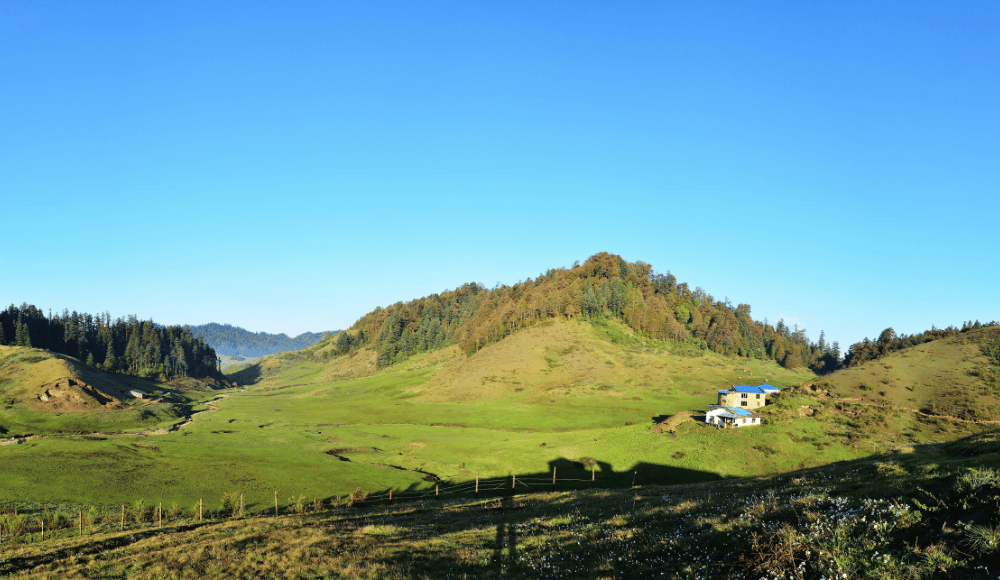
Sahashra Linga, at an elevation of 3200 m, is another holy shrine of this national park. The shrine is a boulder with three cone-shaped structures, worshiped by Lord Shiva, his consort Parvati, and their son Ganesha. This shrine bears huge historical beliefs, and the myth regarding the formation of the shrines can be heard by the nearby villagers. Near this holy land lies another sacred junction of three rivers, Triveni. There is also a Shiva temple where a small fair is organized in auspicious Jyestha Purnima during the festival of Ganga Dashahara.
Apart from the holy shrines, this national park is also home to more than 20 lakes and streams with ethereal-looking meadows and pastures. Among all the lakes, a specific lake in this national park is Khaptad lake, also known as Khaptad Daha. This lake is peculiar because of the two portions within the same lake. One half of the lake water is crystal clear, while the other is brown, fuzzy and a little muddy. This makes the lake even more vivid and quirky.
Leaving the lakes and slowly flowing streams, this national park’s major charisma is the green-looking paradisiacal meadows and the pastures. During the summer, the wildflowers bloom vigorously, making the environment unimaginatively gorgeous, while the spring sparks with the bold crimson red of the flourishing rhododendrons. Aiding the park's beauty are the snowcapped vistas of Saipal Himal.
Though Khaptad national park is an exemplary national park of culture within nature, It does not mean it lacks biodiversity. A variety of biodiversity is observed here. As this national park suffers through a subtropical to temperate climate, the lower region is filled with the broad leaves plant species such as Sal, Sissoo, and likewise and the mid-hills are covered by the colorful Rhododendrons; at the same time, the higher elevation reports medicinal herbs and wild berries.
This grants excellent shelter to animals such as leopards, wild boars, Himalayan black bears, Goral, yellow-throated Marten, Rhesus, and Langur monkey. Also, 260 resident bird species are spotted in this national park, accompanied by seasonal migrators. This offers an excellent bird-watching opportunity in the remote zone inside the peaceful, tranquil hilly ambience. Also, Camping is allowed in this national park, granting the best lifetime experience one can ever get.
Despite the unique biodiversity, and the preserved ecosystem, this national park receives fewer visitors than other national parks. The lack of good advertising and the remoteness may be why the lack of visitors. You just need a national park permit to enter this national park, whose cost ranges vary by nation. Though you can visit this national park year-round, autumn and spring will make your tour a way to heaven so you can choose that time to explore this remote beauty.
Some of the features and attractions of Khaptad national park are listed below:
Khaptad baba Ashram
Khaptad Daha
Sahashra linga
Triveni and the Shiva temple
Beautiful Meadows
You have to take a flight to Nepalgunj from Tribhuvan international airport, Kathmandu, first, then the next flight to Dipayal. After Dipayal, you can drive through the local buses departing to Silgadhi, Doti. From here, you can hike for 2 to 3 hours to reach the Khaptad national park. Also, note that this will only take you to the park entrance, not the park headquarters. You have to hike an extra two to three hours to get to the park headquarters.
Alternatively, you can take a flight to Nepalgunj, next to Bajhang or Achham and the onward trek of two days.
|
National park |
Khaptad national park |
|
Location |
Far western region of Nepal, Bajhang, Bajura, Achham and Doti |
|
Established date |
1984 |
|
Area covered |
225 sq km |
|
Buffer zone |
216 sq km |
|
Preserved Flora and Fauna |
|
|
Activities to do |
|
|
Permit fee |
|
|
Best time to visit |
|
Shuklaphanta national park is the jewel of far-west Nepal. This national park lies in the Kanchanpur district, the extreme southwestern section of the lowland of Terai. The great Mahakali river forms a national boundary between India, Uttar Pradesh in the south and west. At the same time, the park’s northern territory spans up to the Mahendra highway. Towards its east flows the Chaudar river, which acts as a national park's safeguard.
Shuklaphanta national park is filled with extensive grasslands, open fields, rivers, ponds, and heritages. Shuklaphanta is named after the largest Phantas (grassland), Shuklaphanta residing in the national park. Initially, this protected region used to be a hunting reserve, officially given the title of the Royal Shuklaphanta hunting reserve in 1969.
Later in 1973, with an area of 155 km sq, it was gazetted as the Royal Shuklaphanta wildlife reserve, which spans up to the area of 305 sq km in the late 1980s, which is the national park's current year. It has preserved the diverse ecosystem of the far western Terai for over forty years under the same designation. Finally, in 2017, this conservation zone was given the status of a national park, making it the country's youngest national park.
This national park was the kingdom of the Tharu king, Singpal, during the monarchy in the nineties. Still, inside the national park, the remains of the castles can be observed. The half-buried forts and walls inside the national park make this national park a park with high heritage values and significance. Also, a small mesmerizing pond, known as Rani taal, lies inside the national park, adding even more glory to the national park.
This national park is the only peaceful and untamed national park in Nepal. So, every feature and character of the national park is still intact, away from destruction. This grants an excellent opportunity to observe the pristine nature with the representative ecosystem. Mainly this national park is the habitat of several deer species. The extensive grasslands and the wetlands with adequate water resources make this national park an ideal shelter to leap around to this beautiful creature.
Through the survey conducted by Schaff in 1978, this national park was found to hold 24 mammal species, 350 bird species, 14 fish species, and 10 species of ectoparasites and biting flies. Barasingha and Indian hog deer dominate this national park, followed by the other species. The Asian elephants are seen marching to this national park on summer days, while the Feral tigers are increasingly trespassing from the nearby national park of India. Every year Chitwan national park translocates the Indian one-horned rhino to this national park to prevent the extinction of this species.
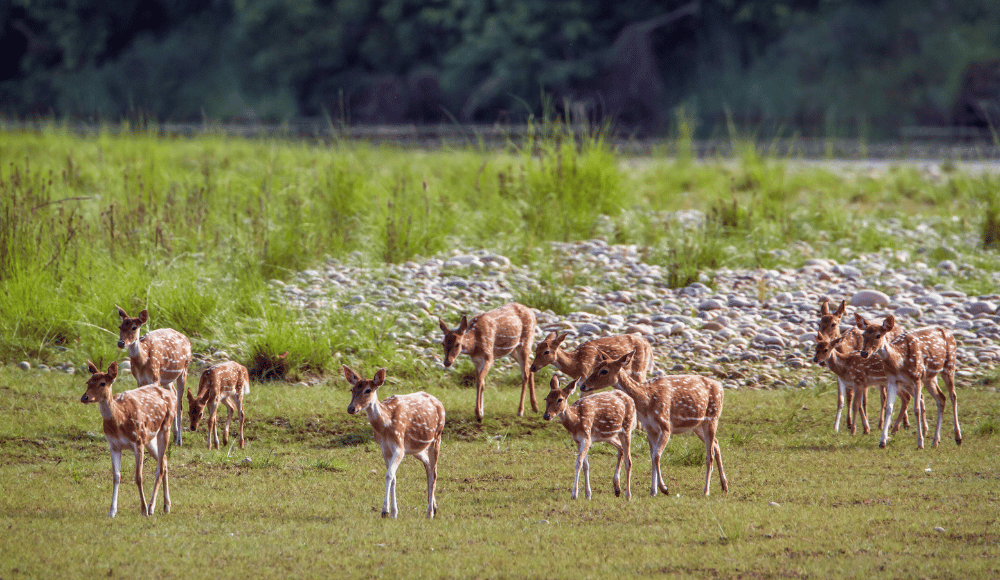
Also, not only are the large predators the only residents of this national park, but several reptiles and amphibians species are also. The poisonous Cobra and its relative types are seen in this national park. The hot, humid days and the rising summer temperature may be the reason behind the large number of such vicious creatures. Though this creature is in the danger category, they are also responsible for maintaining the ecosystem, so this national park is also preserving such species.
More than flora and fauna are needed to color the national park, so the large varieties of birds appear to fill this missing piece. More than 500 species of birds soar in this national park, also joined by seasonal migrators. Such a variety offers the best bird-watching opportunity to visitors. The untrodden trails of the national park in such a tranquil environment with the fantastic landscapes and the lush green grasslands indeed make this national park a hidden gem. On top of that, observing the rare wild beauties in such a serine nature is indeed phenomenal.
Shuklaphanta national park experiences a sub-tropical monsoonal climate. So, it receives maximum precipitation between June and September. Winter hits early with occasional frost, while April and May are extremely hot, which eventually gives the monsoon rain. Because of such a humid environment, vegetation such as Saal and Savannah can occupy most of the forested zone. So, the ideal time to visit this national park can be Autumn and early spring, as the blazing heat makes the summer day unbearable, and the frequent rain kills the fun during the monsoon.
Only one permit is required to visit this national park, which is the Shuklaphanta national park permit. Like others, you can get a national park permit from the Nepal tourism board or the park's headquarters. You can also join the activities such as Jungle safari, bird watching, jungle walking, and hiking during the national park visit, which grants a total immersion in such unparalleled beauty.
Some of the features and attractions of Shuklaphanta national park are listed below:
Swamp deer and its different kinds
Rani Taal
Bengal tiger
Remaining of the Kings fort and castles
Large grassland and meadows
Shuklaphanta national park is easily accessible though it lies farther from the capital. It is easily accessed by the east-west Mahendra highway, a far west sector that passes through Dhangadhi to the national park. The best option to reach this national park is taking a flight to Dhangadhi from Kathmandu, then the three hours bus drive to Mahendranagar. It will take you to the pristine Shuklaphanta national park. Also, you can access the Shuklaphanta national park via drive. For this, you have to take the east-west Mahendra highway bus that goes via Nepalgunj, Dhangadhi, and finally, Mahendranagar.
|
National park |
Shuklaphanta national park |
|
Location |
Kanchanpur district, far western lowland of Terai |
|
Established date |
1976- wildlife reserve, 2017- national park |
|
Area covered |
305 sq km |
|
Buffer zone |
243.50 sq km |
|
Preserved Flora and Fauna |
|
|
Activities to do |
|
|
Permit fee |
|
|
Best time to visit |
Autumn (September, October, November) Spring ( March, April, May) |
There are rules for every protected and restricted area. So, you must follow specific rules while paying for a national park visit. Some of them are listed below:
Don’t offer food to wild beings.
Visit the national park before sunset.
Be cautious while going on the jungle walk and follow the guide's command.
Don’t disturb the animals with a loud noise.
Don’t mock the animals.
Remember you are in a place the wild animals call their home, so don’t perform any activity that will trigger them.
Leave with what you bring, means don't pollute the national park.
You can take photos of the wild beast, but don't get too close to them.
Be quiet and immerse in the sounds and scenic vibes of the national park.
Altogether there are 12 national parks in Nepal. Each national park boasts its own unique diversity with distinct landscapes and varying ecosystems.
Shey Phoksundo national park is the largest national park in Nepal. Occupying an area of 3555m, this national park spreads through the Dolpo and Mugu district, housing the deepest and second-largest lake in Nepal, lake Phoksundo.
Rara national park is the smallest national park in Nepal. Comprising an area of 106 sq km, this national park lies in the western region of Nepal in the Mugu and Jumla districts. Nepal’s largest lake, Rara, settles in this national park.
Chitwan national park is the first national park in Nepal. This national park is also one of the national parks enlisted as a world heritage site in 1984. With Nepal's big, dense Char Kose Jhadi, this national park is preserving several floral and fauna species.
Shuklaphanta national park is the youngest national park in Nepal. Though it was a protected area earlier, it was not officially named a national park, just a wildlife reserve. Later, in 2017, it was given the status of a national park, making it the youngest national park in Nepal.
Sagarmatha National park is a high-altitude national park in Nepal. Ranging up from 2600m to 8884m, this national park is the home of the world's highest peak Sagarmatha. Not only Sagarmatha, this national park houses several other peaks above 5000 and 7000 m.
Conserving the fragile ecosystem in its original form with the sustainable use of natural resources is the main reason behind the national park's formation. So, managing the wildlife and biodiversity within the natural environment can be said to be the purpose of establishing the national park.